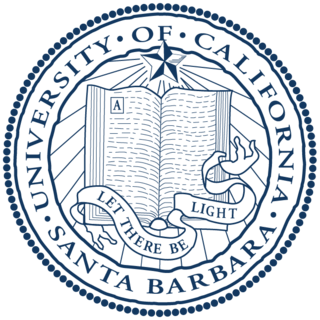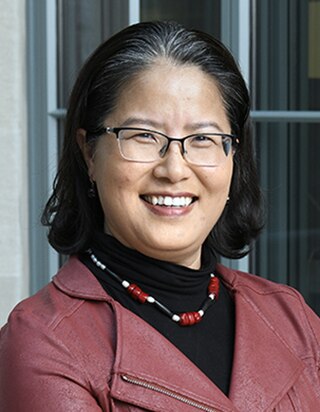
The University of California, Santa Barbara is a public land-grant research university in Santa Barbara County, California, United States. Tracing its roots back to 1891 as an independent teachers' college, UCSB joined the University of California system in 1944. It is the third-oldest undergraduate campus in the system, after UC Berkeley and UCLA.
Craig Jon Hawker is an Australian-born chemist. His research has focused on the interface between organic and polymer chemistry, with emphasis on the design, synthesis, and application of well-defined macromolecular structures in biotechnology, microelectronics, and surface science. Hawker holds more than 45 U.S. patents, and he has co-authored over 300 papers in the areas of nanotechnology, materials science, and chemistry. He was listed as one of the top 100 most cited chemists worldwide over the decade 1992–2002, and again in 2000–2010.
Jing Li is a Board of Governors Professor of Chemistry and Chemical Biology at Rutgers University, New Jersey, United States. She and her team are engaged in solid-state, inorganic and inorganic-organic hybrid materials research. Her current research focuses on designing and developing new functional materials including metal-organic frameworks and hybrid semiconductors for applications in the field of renewable and sustainable energy, and clean environment.
Bruce H. Lipshutz is an American chemist. He is a professor at the University of California, Santa Barbara.
Guillermo Carlos Bazan is an American chemist, material scientist, and academic.

Lise Getoor is an American computer scientist who is a distinguished professor and Baskin Endowed chair in the Computer Science and Engineering department, at the University of California, Santa Cruz, and an adjunct professor in the Computer Science Department at the University of Maryland, College Park. Her primary research interests are in machine learning and reasoning with uncertainty, applied to graphs and structured data. She also works in data integration, social network analysis and visual analytics. She has edited a book on Statistical relational learning that is a main reference in this domain. She has published many highly cited papers in academic journals and conference proceedings. She has also served as action editor for the Machine Learning Journal, JAIR associate editor, and TKDD associate editor.
The De Gennes Prize was established in 2008 and is awarded biennially by the Royal Society of Chemistry for outstanding and exceptional work in the field of materials chemistry. The de Gennes Prize honours the work of Pierre-Gilles de Gennes.
Vincent Rotello is an American materials scientist and engineer currently serving as Charles A. Goessmann Professor of Chemistry and University Distinguished Professor at the University of Massachusetts Amherst and the current editor-in-chief of American Chemical Society's Bioconjugate Chemistry. He joined the faculty at the University of Massachusetts in 1993, and has been the recipient of the NSF CAREER, Cottrell Scholar, Camille Dreyfus Teacher-Scholar, and Sloan Fellowship awards. More recently, he has received the American Chemical Society's Langmuir Lectureship (2010), and in 2016 he received the Transformational Research and Excellence in Education Award presented by Research Corporation, the Bioorganic Lectureship of the Royal Society of Chemistry, the Australian Nanotechnology Network Traveling Fellowship, and the Chinese Academy of Sciences, President's International Fellowship for Distinguished Researchers. He is a fellow of both the American Association for the Advancement of Science (AAAS) and of the Royal Society of Chemistry. He is also recognized in 2014, 2015 and 2018 by Thomson Reuters/Clarivate as Highly Cited Researcher. He is currently the Editor in Chief of Bioconjugate Chemistry, and is on the Editorial Board of 14 other journals. His research program focuses on using synthetic organic chemistry to engineer the interface between the synthetic and biological worlds, and spans the areas of devices, polymers, and nanotechnology/bionanotechnology, with over 550 peer-reviewed papers published to date. He is actively involved in the area of bionanotechnology, and his research includes programs in delivery, imaging, diagnostics and nanotoxicology.
Caroline Masiello is a biogeochemist who develops tools to better understand the cycling and fate of globally relevant elemental cycles. She is a professor at Rice University in the Department of Earth, Environmental and Planetary Sciences and holds joint appointments in the Chemistry and Biochemistry Departments. Masiello was elected as a Fellow of the Geological Society of America in 2017. She currently leads an interdisciplinary team of scientists who are developing microbial sensors for earth system science.
Alison Butler is a Distinguished Professor in the Department of Chemistry and Biochemistry at the University of California, Santa Barbara. She works on bioinorganic chemistry and metallobiochemistry. She is a Fellow of the American Association for the Advancement of Science (1997), the American Chemical Society (2012), the American Academy of Arts and Sciences (2019), and the Royal Society of Chemistry (2019). She was elected a member of the National Academy of Sciences in 2022.
Michelle O'Malley is an American chemical engineer and professor at the University of California, Santa Barbara. She is known for her work studying the use of anaerobic microbes in developing inexpensive biofuels. In 2015 she was named as one of MIT Technology Review's 35 Innovators under 35, and in 2016 she received the Presidential Early Career Award for Scientists and Engineers.
Julia Ann Kalow is an assistant professor of chemistry at Northwestern University. She is primarily a synthetic chemist, who works on polymers, photochemistry and tissue engineering. She is interested in synthetic strategies that can turn molecular structure and chemical reactivity into macroscopic properties. She has been awarded the National Science Foundation CAREER Award, Thieme Award and was selected by the University of Chicago as a Rising Star in Chemistry.

Rachel A. Segalman is the Edward Noble Kramer Professor and Department Chair of Chemical Engineering at University of California, Santa Barbara (UCSB). Her laboratory works on semiconducting block polymers, polymeric ionic liquids, and hybrid thermoelectric materials. She is the associated director of the Center for Materials for Water Energy System, an associate editor of ACS Macro Letters, and co-editor of the Annual Review of Chemical and Biomolecular Engineering.
Beth L. Pruitt is an American engineer. Upon completing her master's degree in manufacturing systems engineering from Stanford University, Pruitt served as an officer in the United States Navy. She is a full professor of mechanical engineering, biological engineering, and biomolecular science & engineering at the University of California, Santa Barbara. She is a fellow of both ASME and AIMBE.
Sarah Helen Tolbert is an American chemist who is a professor in the department of chemistry and biochemistry at the University of California, Los Angeles. Her research considers self-assembled nanomaterials, which includes inorganic phases and colloidal materials.

Fred Wudl is an American materials scientist, academic researcher. He is a Professor Emeritus in the Department of Materials Engineering at the University of California, Santa Barbara.

Joan-Emma Shea is an American chemist who is a professor at the University of California, Santa Barbara. Her research applies statistical and computational approaches to address biological problems. She is a Fellow of both the American Physical Society and the American Chemical Society, and the editor-in-chief of the Journal of Physical Chemistry.

Songi Han is an American chemist who is a professor in the department of chemistry and biochemistry at Northwestern University. Her research considers electron and nuclear spins as sensors and detectors. She was elected a Fellow of the International Society of Magnetic Resonance in 2019 and president of the International EPR Society in 2020.
Amanda Morris is an American chemist who is the Patricia Caldwell Faculty Fellow and professor of inorganic and energy chemistry at Virginia Tech. Her research considers next-generation materials for catalysis and light-harvesting. She was elected chair of the American Chemical Society Gay and Transgender Chemists and Allies committee in 2021.






